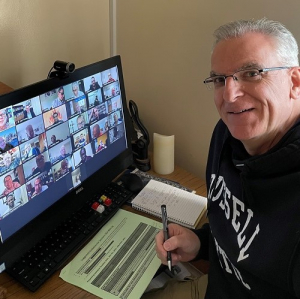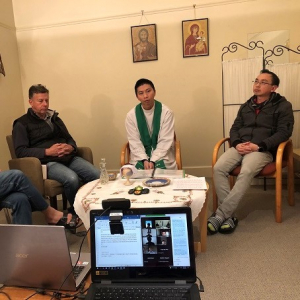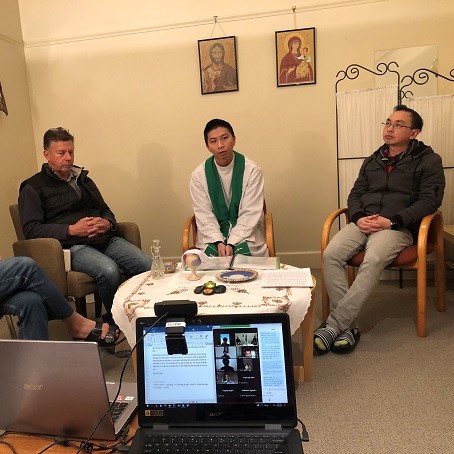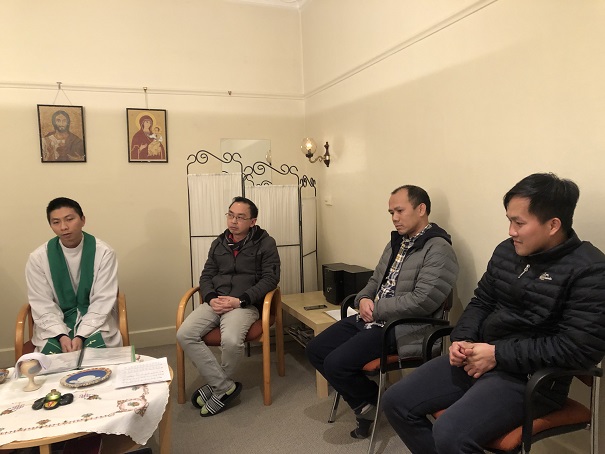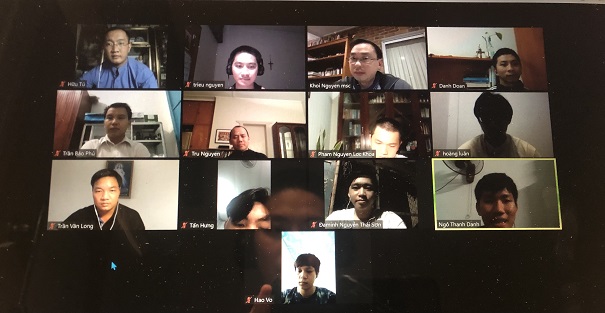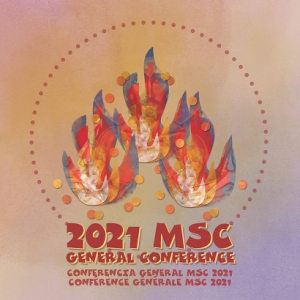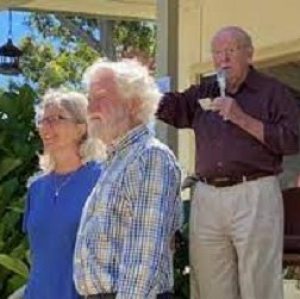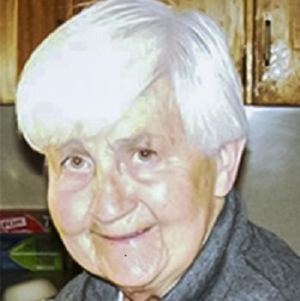Peter MALONE
Catholic Church affirmation of the Uluru Statement from the Heart.
Catholic Church affirmation of the Uluru Statement from the Heart.
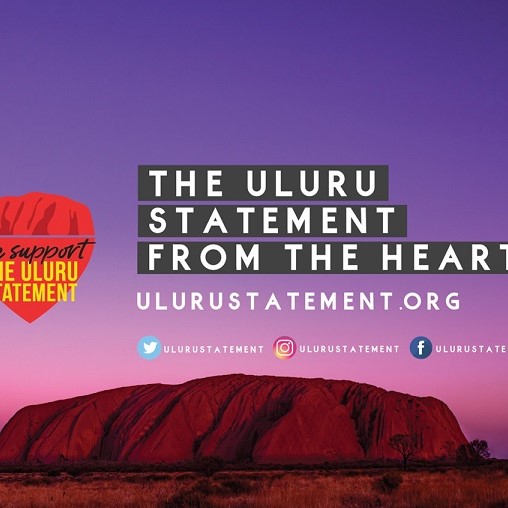
The Missionaries of the Sacred Heart have been living and working with our Indigenous Brothers and Sisters since 1906 in the NT, Palm Island, Wilcannia, Balranald and Bourke, Erskineville. We affirm the Uluru Statement from the Heart.
Brisbane Archbishop Mark Coleridge has publicly endorsed the Uluru Statement from the Heart in an historic commitment by the Church to back Indigenous leaders demanding a constitutional voice. Source: The Catholic Leader.
“Only a heart of stone could allow the indigenous peoples to become aliens, exiles, and refugees in their own land,” Archbishop Coleridge said during Mass for First Nations leaders and parish representatives at the Santa Teresa Spirituality Centre in Ormiston, east of Brisbane.
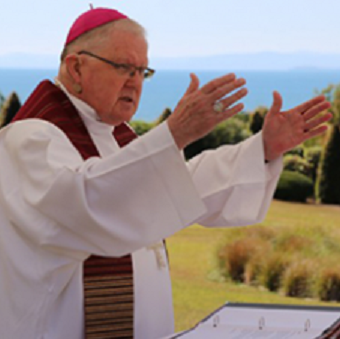
Archbishop Mark Coleridge (The Catholic Leader/Mark Bowling)
Standing on Quandamooka country, Archbishop Coleridge, president of the Australian Catholic Bishops Conference, gazed across Moreton Bay to Stradbroke Island (Minjerribah), site of Australia’s first Catholic mission to First Nations peoples, set up by Italian Passionist Fathers more than 170 years ago.
“God is going to take out of us that heart of stone and give us a heart of flesh – the heart of Jesus… that recognises the other as a human being,” he said.

“What has been done to the Indigenous peoples of this land could only have been done by denying that they were in fact human – they were at best perhaps subhuman.
“A heart of flesh says no to that, absolutely no.”
Speaking just days before the start of the first assembly of the Church’s historic Plenary Council of Australia, Archbishop Coleridge described the poor health and incarceration rate indigenous Australians – the highest in the world – as “a national disgrace”.
Following Mass, Archbishop Coleridge formerly endorsed the Uluru Statement From the Heart, a landmark document signed by 250 indigenous leaders in 2017 and invited all Australians “to walk with Aboriginal and Torres Strait Islander peoples” towards a better nation.
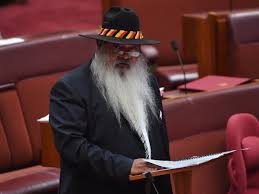
Pat Dodson, Senator, shared MSC life for many years.
Report: End of MSC General Conference 2021
Report: End of MSC General Conference 2021

Superior General, Abzalon, has written his response and exhortation – it will be posted on Saturday for reading and weekend reflection.
Last night Australian time we had the last session of the MSC General Conference 2021 which was held on line because of the pandemic. It was to be in Brazil this year. There were 44 participants in all where the General Leadership Team met with Major Superiors from all the MSC Provinces and Unions from around the world. Other participants were from the General Administration, including Tim Brennan from the Safeguarding Office. The two facilitators were from the General Leadership Team, Chris Chaplin from Australia and Humberto Henriques Silva from the Sao Paulo Province in Brazil.
Preparation for this major event began back in the early part of this year when the General, Abzalon Alvarado Tovar, contacted six of us around the world to set up a Hosting Team to organize and facilitate the whole on-line event. From Australia I was asked to be the Coordinator of the Hosting Team consisting of Brett Adamson, Kenji Koda, and Michael Angelo Acera from the Philippines, Ireneo Lee from Korea, and Tiago Donizete from the Rio Province in Brazil. There were also two secretaries from the General House and an interesting inclusion was Richard Kim from Korea who had the task of ‘visual listening’ and providing a ‘sketch’ at the end of each day capturing visually the processes of the day. They are included in the YouTube video attached.
When all was in order we began with three days in June, three days in August and the last five days in September, just gone. Each day was a two hour session on Zoom beginning at 12.00 noon Rome time, and whatever equivalent time in the various places where the participants lived. Here in Australia that was between 8.00 pm and 10.00 pm fortunately for us. Others had very early morning or late night starts.
The business of the conference was threefold Firstly to identify and decide on issues on which the Conference has the authority to make decisions, secondly to identify issues and make recommendations that the General Leadership Team can decide on in the next two years leading up to the next General Chapter, and thirdly to determine matters that will be passed on to the next General Chapter for discussion and decisions in Rome in 2023. Much of this was contained in materials sent to all the participants and requiring a lot of reading and reflection in the times between the sessions. The sessions themselves consisted of times of prayer, reflection, and discussions in Break Out Rooms based on language before coming back to a Plenary session.
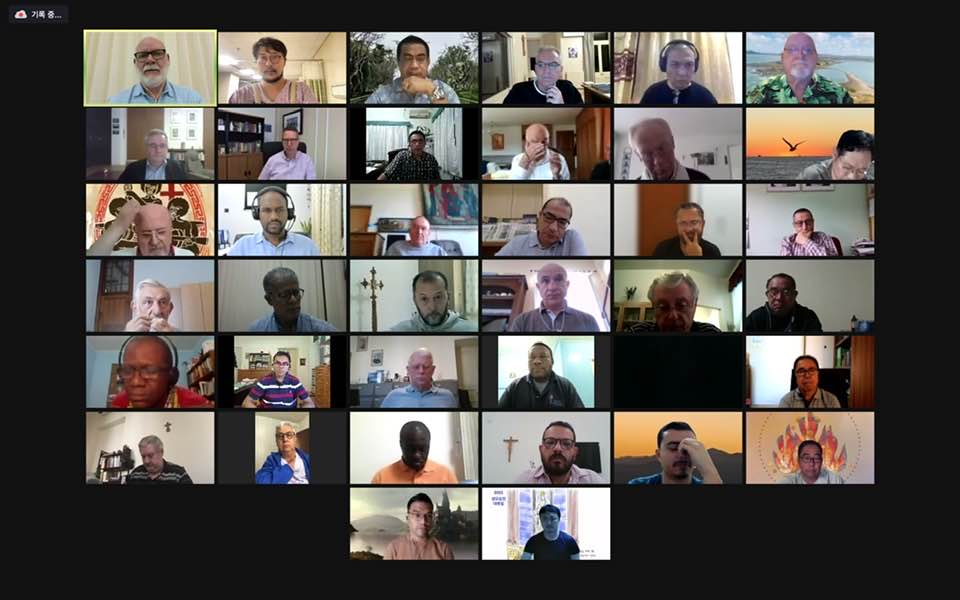
I was surprised at how well this process works. The translators did an amazing job. All that could be done in a face to face conference can be done on-line, except the interpersonal moments over meal and drink breaks that are part of the face to face meetings and the kind of informal sharing of information that takes part there. Many participants, while praising the process in their appraisal, commented on this lack of personal interaction. Even the old butcher paper technique was replaced by a mentimetre – like a jigsaw puzzle of words from participants provided in feedback to the Plenary sessions also seen in the YouTube video- provided by Ireneo Lee. Click HERE.
Feedback from participants was overwhelmingly positive, with the exception mentioned above.
The journey continues as we now move towards Provincial Chapters and the General Chapter in 2023.
Roy John O’Neill MSC
Coordinator
2021 MSC General Conference
Vocations’ promotion. Zoom weekend retreat, Blackburn and Vietnam
Vocations’ promotion. Zoom weekend retreat, Blackburn and Vietnam
Trieu Nguyen MSC, who organised this retreatm writes. The retreat went well according to the feedback of participants. We had 9 men who joined the retreat, including Long, our pre-novice who was invited by Khôi. The retreat was for discerning vocation, MSC or other.
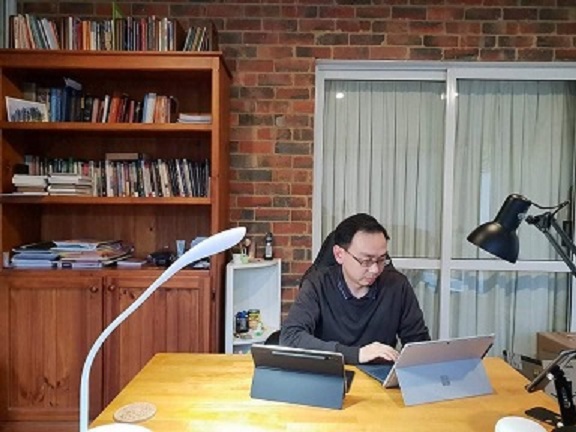
The retreatants were impressed with the way we ran the program and the atmosphere of friendliness and equality. For all of us, it was the first time to join an online retreat. We also had the accompaniment of Danh and Trụ for spiritual direction.
We celebrated the final mass with the presence of other community members. There was a surprise moment for retreatants because they are not familiar with sitting at Mass.
There are plans for another (offline) retreat in November for local participants.
Two new appointments.
Two new appointments.
Meta Jackman: We congratulate Meta who has accepted the invitation to be on the inaugural MSC Safeguarding Commission of the General Council.

The other three members are Ms Christina Campbell (Glasgow), Fr James Espuerto MSC (Philippines Province) and Ms Mary Tallon (Ireland). Meta has done outstanding and tireless work as Director of Professional Standards and Safeguarding for the Australian Province. The first meeting will be via Zoom in early October.
Stephen Hackett MSC: The Pope will launch the global process next month in Rome, with dioceses to launch a months-long period of consultation on October 17, followed by national and regional consultation.
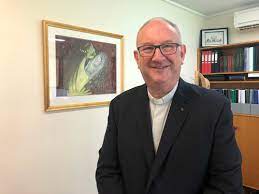
Trudy Dantis, the director of the National Centre for Pastoral Research, has been appointed to lead the Australian engagement with the Holy See. Other members of the national committee are Daniel Ang, director of the Sydney Centre for Evangelisation; Bishops Conference general secretary Fr Stephen Hackett MSC; Australian Catholic Council for Pastoral Research chair Professor Gabrielle McMullen; Diocese of Sale liturgy and pastoral ministry coordinator Sophy Morley; and Plenary Council facilitator Lana Turvey-Collins.The committee is being supported by staff from the National Centre for Pastoral Research.

Zooming in on the General Conference.
Zooming in on the General Conference.
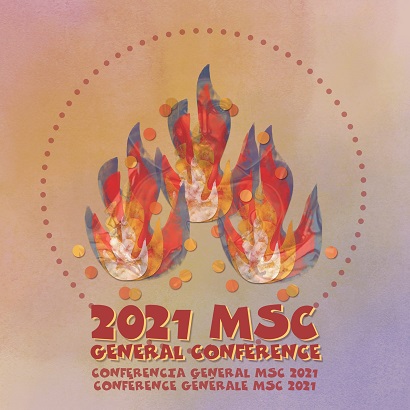
The General Conference is taking place this week.
One picture worth a thousand words. In this picture there are 31 individual pictures, so with the main photo, here are the equivalent of 32,000 words!
For your consideration!
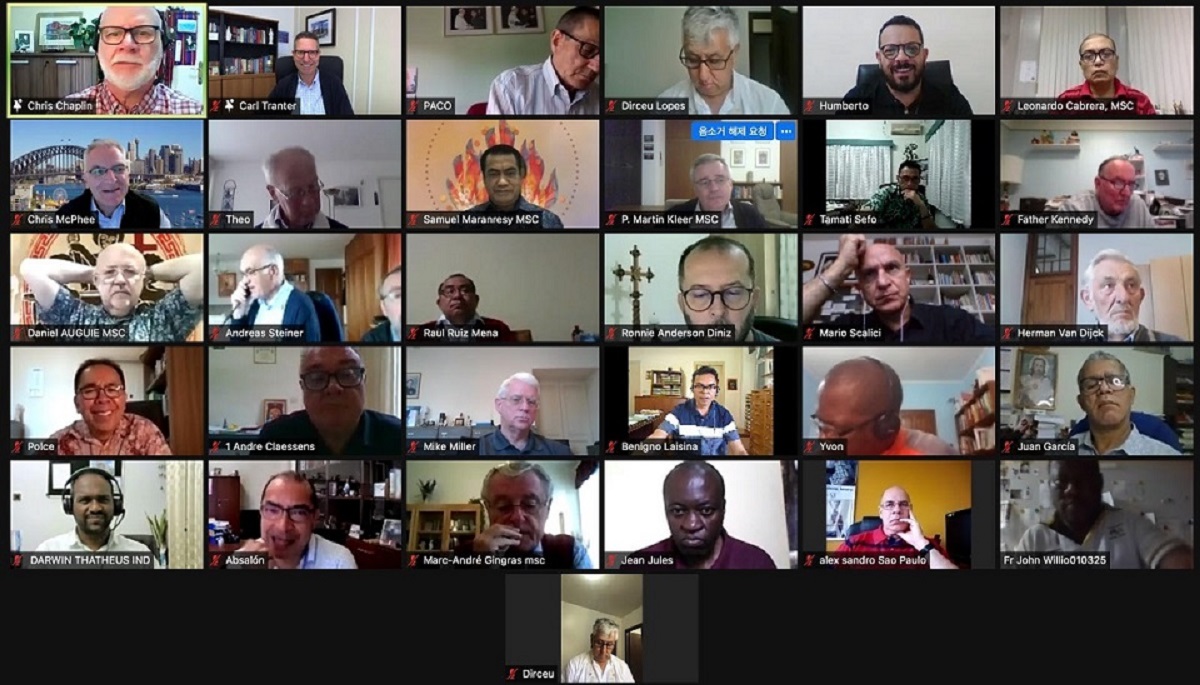
New Director, Heart of Life Centre for Spiritual and Pastoral Formation, Clare Shearman.
New Director, Heart of Life Centre for Spiritual and Pastoral Formation, Clare Shearman.
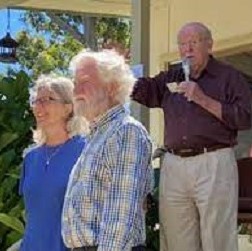
Clare and her husband, Artie, with Brian Gallagher, Shoreham 2021
21 September 2021
Dear Friends of Heart of Life,
It is with great pleasure that I announce the appointment of Clare Shearman as Director: Heart of Life Centre for Spiritual and Pastoral Formation, effective 1 January 2022. The selection process took place over several days, with a panel of five members chaired by Rev Fr Chris McPhee msc, the Provincial Superior of the Missionaries of the Sacred Heart Australian Province.
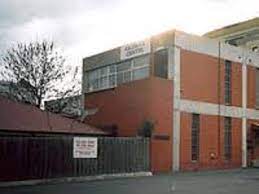
I am very grateful to the selection panel for their participation in the selection process, and for their wise and considered reflections which led to a unanimous decision to appoint Clare to the position of Director. Clare will work closely with me during November and December and will be ready to assume full responsibility of Heart of Life from 1 January next year. Clare will be the fifth person to occupy this position, following on from Brian Gallagher msc, Sue Richardson pbvm, Cheryl Bourke pbvm and myself.
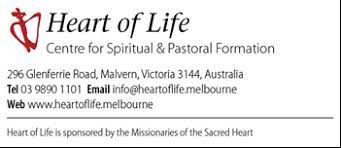
I ask you to please join with me in congratulating Clare on her upcoming role as Director: Heart of Life Centre for Spiritual and Pastoral Formation and we look forward to the continued growth and development of Heart of Life under her direction.
Very best wishes.
Paul
Eulogy: Sr Patricia Mary Mawn fdnsc (9.5.1926 - 6.9.2021)
Eulogy: Sr Patricia Mary Mawn fdnsc (9.5.1926 - 6.9.2021)

I want to say one word to you and this word is joy. Wherever consecrated people are, there is always joy! - Pope Francis
This simple statement is a beautiful summary of our dear Sr Patricia Mawn’s whole life: a rich life of 95 years, lived with Jesus and for Jesus. On September 6th our dear Sister Patricia or Pat as she was known gently and peacefully breathed her last breath as she surrendered to her loving God whom she had served lovingly and faithfully as a Daughter of Our Lady of the Sacred Heart for over seven decades.
To Pat’s relatives, especially her cousins, Margaret, Tom, Claire and Brian and their families, who loved her so much and are deeply saddened by her death, we offer our deep sympathy and love. We also offer sympathy to those who join us from around the world, especially, our Sisters the Parishioners and our associates from Corinda.
It was on 21st October, 1928 that Pat was baptised at St Francis Church, West End in Brisbane. At this time, she was known as Dorothy Dashwood, being the daughter of Charles Dashwood and Isabella Callahan. Soon after this she was adopted by Francis and May Mawn and received the name Patricia Mary. She then became the much loved only child in a devout Catholic family who by their loving example and deep faith formed our dear Pat’s loving, generous heart. She tells us that for years their house was open for the priests who came to say Mass and each of these would stay for the weekend. It is clear that Pat inherited her open welcoming heart from her parents.
Because her father was a policeman, she was influenced greatly by the many moves around the city and outback Queensland. She was educated by the Sisters of St Joseph and the Good Samaritans in Brisbane, at a State school in North Queensland, and spent four years boarding at a school conducted by the Sisters of Mercy at Huberton. It was at these schools that she received her music lessons and her great and lifelong love of music.
After she left school she worked for some years as a telephonist in different country towns. For her like many others of her age the years of the second World War left a lasting effect on her. She clearly remembered that during her time in North Queensland several divisions of the Army were stationed nearby. Then, in 1948 she joined the Novitiate of the Daughters of Our Lady of the Sacred Heart in Bowral. Her Parish Priest wrote a glowing report about her during the time he knew her from 1943. He tells us that she was a good, pious, and exemplary Catholic girl who gave religious instruction to the children of the parish and prepared them for their first confession and Holy Communion and helped with turning the local hall at Landsborough into a church for the Sunday Mass. At times she also acted as the Altar Server. Pat was a capable young woman and when she saw a need she responded with enthusiasm and joy.
When she was professed in July, 1950, she began her life long ministry as a music teacher. She was a wonderful teacher, very gentle and caring of all her pupils. To become better equipped for her teaching in 1960 she gained her Association in Music, a diploma awarded to outstanding candidates in musical performance and theory. After this she taught music in OLSH Schools in many parts of Australia including Toowoomba, Daceyville, Alice Springs, Darwin, Mascot, Bowral, and Kensington. Her music teaching began and ended in her much loved Corinda. In community she is remembered as always being interested in others, full of fun and a pleasant person to be with who enjoyed her recreation time.
During her retirement in Corinda she kept up with her music by playing the organ in the church for many years and she so loved playing music that frequently at night she went into the back room of the convent where there was a piano and with her headphones on, so as to not disturb anyone, she would play the piano for quite a long time. She also played the guitar, which came to St Joseph’s with her and which she played whenever she could, until her fingers could no longer pluck the strings. Pat was a much-loved member of the Corinda Parish, She was especially loved by our OLSH Associates in Corinda for her graciousness, listening ear and sense of humour.
She kept busy with other interests too. Pat helped with Meals on Wheels and the people she worked with thought very highly of her. She made good friends among those she worked with preparing the meals in the kitchen for the drivers to collect. She did this for many years each Friday after Mass at Canossa. Pat loved travel. She really loved going by train. Each year she would go on a train trip to Cairns; stay in a backpacker hostel there for a couple of nights; and then make her way back to Corinda by train. Her last trip was just before she turned 90. When she knew she could not manage it any more, she just said, “this was my last trip”, and she was very sad about it. If Pat needed to go to Sydney, her preferred mode of transport was by train. She couldn’t be persuaded to go by plane. Pat enjoyed family gatherings with her cousins Margaret and Tom and she loved her trips to Bilinga. Quite often she went on these trips with her cousins Claire and Brian, who remember these times with great fondness
Pat was a deeply spiritual woman. At Corinda she was known to sit in the Chapel for hours at a time just conversing with her God. She loved these times and her life at this stage centred around these precious moments of prayer. She could say with Fr Jules Chevalier, “After so many signs of love, could we hesitate in giving him our boundless trust.”
Those who lived with Pat can say that their lives were greatly enriched from having known her, because in her own quiet, and determined way, she had so much to give and always gave graciously.
In 2019, as Pat’s health was failing, she joined the community of St Joseph’s at our aged care facility, where she was beautifully cared for until her death.
We thank God for the many gifts given to Sr Patricia, we thank the Mawn family for their gift of her to our religious family. We know Pat loved her family greatly and held her cousins close to her heart.
We thank you Pat for your welcoming heart, your deep spirituality, graciousness, and warm smile. May your gentle soul rest in peace.
Quarry, The
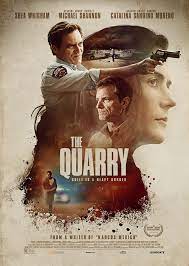
THE QUARRY
US, 2020, 98 minutes, Colour.
Shea Whigham, Michael Shannon, Catalina Sandino Moreno, Bobby Soto, Bruno Bichir, Alvaro Martinez, Jimmy Gonzales.
Directed by Scott Teems.
The Quarry is a small but intriguing drama. It also has a religious theme, an escaped prisoner taking the identity of a pastor in and taking his place in the small Texas town. (Cinemagoers may remember the Polish film, Corpus Christie, where a young worker is mistaken for the parish priest and he assumes the role with quite an effect on the congregation.)
The film opens with the pastor driving to a new parish after his sexual relationship that led to his condemnation. He gives a lift to a man on the side of the road, feeds him, stops at the quarry, confesses to him, urging the stranger also to confess. Instead, the man, revealed as a former prisoner who has escaped, police and helicopter search for him, kills him.
There is quite some drama in the small town as the alleged pastor settles in, looked after by a Hispanic housekeeper, his luggage stolen from the van, discussions with the local sheriff, his taking up the ministry, speaking by way of translated to a small congregation, congregation gradually increasing, his having to conduct a baptism in the river by immersion, officiate at a funeral…
The film has a strong cast. It is a star vehicle for character actor, Shea Whigham, as the escaped convict. Michael Shannon as the sheriff. Catalina Sandino Moreno is the housekeeper, Bobby Soto is her cousin, a drug dealer who is accused of stealing the pastors goods, along with his younger brother, then of the murder of the pastor when his skeleton is discovered. He continues to protest his innocence and blames the new pastor.
The film is a psychological study – of all of the characters and their complexities in the small town. However, it is also a story about the need to confess, to be free of guilt, and even to atone.
- The title? What happened in the quarry? The visuals of the quarry?
- A story of West Texas, the open plains, the small town, streets, homes, police precincts, the church, the quarry and the river? The musical score?
- The story of The Man, no name given, lying on the side of the road, saved by David Martin, in the truck, week, at the diner, the water, the food? David Martin and his ministry, travelling to the town? The Man in his response to the hints, the police helicopter, not telling his story? Martin telling his story, at the quarry, the confession, his misbehaviour, religious guilt, trying to persuade The Man to confess? The Man and his reaction, hitting Martin, his death? Dragging him, burying him?
- The man taking Martin’s identity, going to the town, the church, the encounter with Poco, his band being robbed? The meeting with Celia? With John?
- The Man and his decision to be the religious Minister, the Bible? Going to the church? The few people coming, not speaking English, the translation? His reading of the texts? The impact of hearing the texts? More people coming to the church? His saying he was a sinner? The response of the people? The woman wanting to be baptised, the ceremony on the river? The Man and his being able to sustain his role, the stole, the robe?
- Poco and Ramon, stealing from the van, going through the clothes, the purple flowers, the bloodstained clothes? Ramon and his suspicions? The brothers and the flight, Ramon arrested, imprisoned, bashed, his confession? Three days in prison? His complaints about The Man?
- John, memories of his father, the law, his associates, imprisonment of Ramon? Suspicions of drug deals – and Poco later with the marijuana plants? The pursuit of the brothers, imprisoning Ramon? Questions? The finding of the body, assumption of guilt, someone from across the border? John and his relationship with Celia, her being a cousin of Ramon?
- Celia, coming to Texas as a child, staying, at the church, the various ministers coming and going? Her relationship with John? Her reaction to The Man, helping him, conversations, singing the hymn?
- Ramon and the lawyer, his refusal? The judge and the travel, in court, The Man coming in his robe, the hesitation about his name, eventually saying David Martin? The proceedings, Ramon, the upset, Poco running?
- The finding of the body, decomposed, the clue of the flowers? The Man and his conducting the ceremony?
- Celia, leaving, back to Mexico, poco?
- The Man, his feelings of guilt, flashbacks to David Martin? In the boat, Ramon in the boat, his complete confession to Ramon, the death of his wife and her lover, of David Martin? Ramon killing him?
- Themes of sin, guilt, confession, atonement, forgiveness, retribution?
MSC GENERAL ADMINISTRATION MEETINGS
MSC GENERAL ADMINISTRATION MEETINGS

This week sees the next phase of the General Conference, all by Zoom. Chris Chaplin, third counsellor, consigliere terzo, offers a reflection on the functioning of the General MSC Administration.
Thrust into international leadership three years ago, the General Leadership Team has had a very steep learning curve in its first three years. Apart from the massive task of five strangers coming together from the four corners of the earth to build a cohesive team, was the mystery of learning how administrations operate at the General level. Bumping up against the edges of congregational structures, we gradually discovered how the boundaries define an administration, and how open or closed they were to its influence.

Administrations are made up of people. Roles and responsibilities, functions and systems don’t actually exist separately to the individuals who shape them. So, one of the significant undertakings of the Leadership Team has been to work together with the permanent members of the General Administration to co-create a group who can relate well and function in service of the Society’s mission.
Our constitutions use the term “collaborators” for the members of the General Administration that include the Secretariat, Bursar, Postulator, Procurator, Archivist and since 2018 a permanent position for Safeguarding. In the last six months there have been some significant changes of collaborators. Benny Laisina has taken Hans Ngala’s position as Bursar, Robertus Sumarwata finished as Archivist, and Hengki Ponamon will begin archive training programs this year, while Polce Pitoy acts in that role for the present time. Richard Suresh has joined the Secretariat as an Assistant to the Administration. As collaborators, all these people co-labour for the whole Society, but one might be mistaken in thinking that they are here to labour for the other group – the General Council.
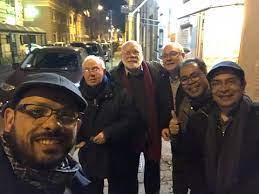
The vision of leadership that steers us is better imagined as a complete circle of equal parts having different functions. We have moved away from constitutional terminology such a collaborators and councils to a language which better describes the leadership paradigm out of which we aspire to work. We speak of the council as a leadership team and the collaborators as an administrative team, together forming the one General Administration.
Calling on the wisdom of the group we have developed some organisational strategies to strengthen both teams and the administration as a whole. We have begun to have quarterly meetings of individual offices with the leadership team. The initial purpose of these meetings is to develop a common understanding of the roles and responsibilities of each member of the Administration. These are also opportunities to hear specific issues and to affirm individuals in the gifts they bring to their ministries.
It has also been important to institute quarterly meetings of the whole administration so that everyone hears everyone, including those in an assistant role, one of whom is Ms. Sophia Amante, a laywoman whose exceptional contribution in our finance office and management of the domestic needs of the General House is gratefully acknowledged. Team leadership should encourage the voice of all the players no matter what their position. This builds ownership and trust. Equally everyone has the responsibility of listening in such a way that all feel heard. Indeed, empathic, and generative listening is at the heart of this vision of leadership. Everyone in the team is called to accept the leadership of their own role so that we develop a team of leaders who can together follow the common wisdom, rather than a leader with a team of followers following his wisdom.
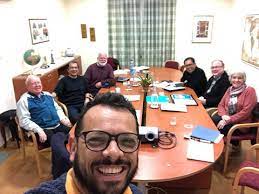
The sound of joy in a team says something about the quality of the relationships that exist between them. We have discussed how our Administration gatherings should not be business only, but also social opportunities, times of prayerful deep listening in communal wisdom, retreats in common, and supported group work with external facilitators who can help develop cohesiveness and effectiveness. All of this contributes to a happy working environment, which motivates our willingness to give ourselves fully in service of the wider community of members in our entities.
I conclude with a word of gratitude to all the Administration for their willingness to embrace these processes so readily. Thank you.
Breaking News in Yuba County
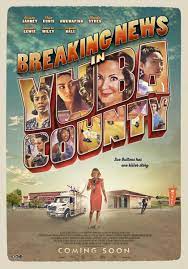
BREAKING NEWS IN YUBA COUNTY
US, 2021, 96 minutes, Colour.
Alison Janney, Mila Kunis, Regina Hall, Awkwafina, Wanda Sykes, Ellen Barkin, Matthew Modine, Jimmi Simpson, Keong Sun, Juliette Lewis, Clifton Collins Jr, Samira Wiley, Bridget Everett, T.C.Metherne, Dominic Burgess.
Directed by Tate Taylor.
How well do Americans take to satire and parody? Generally, American comedy tends to be fairly broad, obvious, pratfalls and slapstick, and, as the decades have gone on, a move from innuendo to straightforward and crass language and situations. This is not the case here. This one is far more similar to the ironic parody of Saturday Night Live.
The structure of the screenplay is clever. Initially, there is a focus on one character, Sue, the timid housewife, trying to reinforce herself-confidence with mantras about her being important and significant. (And part of the parody is that this character is played, very effectively and credibly, by the tall Alison Janney, so strong in performances in I, Tonya and The West Wing.) It is her birthday and she has to buy her own cake, work associates happily buying a cake for another worker and ignoring her, her husband (Matthew Modine) forgetting her birthday.
In fact, this will all lead to an extraordinary tangle involving her husband, a motel, a liaison, Sue surprising him, his heart attack – and, the police or not, and disposing of the body.
But, Sue doesn’t go to the police. What follows is an extraordinarily complex black comedy of errors, the discovery that the husband was laundering money at the bank, his delinquent brother, Pete (Jimi Simpson whose wife is now pregnant with twins) is entangled with two tough petty criminals (Awkwafina and Clifton Collins Jr), who have no scruple in killing, and standover tactics on behalf of a local businessman and the laundering of his cash. There is a large bag of cash buried with the body!
As if that isn’t enough, the brother is reforming, works for the hard-nosed, wisecracking proprietor of a store (Wanda Sykes in stand-up comedy mode) who has seen all the TV films about how gangsters work and wants to be in on the act, including robbing a jewellery store to pay for a ransom.
It all gets very complicated (as if it wasn’t complicated enough) when Sue’s half-sister, Mila Kunis, a minor TV personality, who wants to interview Sue. But, there is a more high-powered television interviewer on a more prominent channel, played unctuously by Juliette Lewis, and Sue would rather be on her program. Sue discovers that, while she might put herself down, media limelight is more than attractive.
Oh, yes. There are also the police, Sue reporting her husband missing, their staking out her house, bemused by her behaviour, tracking down the brother of the store…, the bumptious woman Sue’s husband was having the affair with.
But, this being a black comedy, the writer has no particular concern about characters being killed off. And, mostly they are! All kinds of surprise scenes, variations on the action thriller conventions, always some surprises. And, despite Sue almost exposed by the truth, she is able to sail through all the hazards, even to writing a book about her experiences, sharing them with the host on the TV show who was also written a book!
A very good example of how Americans can do satirical black comedy. If you would like another film in the same vein, a recommendation is Bad Times at the El Royale (also with a large and interesting complement of character actors and comics).
- The nature of American comedy? Broad? Action? The contrast with satire and parody, irony?
- The comic nature of the screenplay, characters, caricatures, situations, tangles and twists, satire, parody, moralising targets?
- The town in Yuba County, homes, workplaces, banks, shops, businesses and money-laundering, police precincts, the television world, studios, local filming…? The musical score?
- Sue’s story? Alison Janney and her presence and performance? Age, relationship with her husband, with her half-sister, self-image, repeating the mantras about her life being important? Buying the cake for her birthday, the wrong spelling, paying for it herself? At work, thinking the cake was for her, but for the fellow-worker? Her husband forgetting her birthday? Going to see him, going to the car, the bunch of flowers? Following him, getting the information at the motel, the confrontation, the shock, his heart attack and death? The girlfriend, hurrying away? Sue, the decision to bury her husband on the grounds, and burying the bag, not knowing what was in it?
- The consequences, her going home, eating the cake, the temper tantrum, creating the mess in the house? Her going to the police, their being busy, the range of people being brought in? Harris, not taking enough notice of Sue? Visiting the house, asking the questions, her assistant? The inconsistencies? The talk of missing, of abduction? Stood down, her persevering, the interviews and discussions with Sue, observing Leah, tracking her down, at the motel, the surveillance camera?
- Sue and her sister, television, agreeing to the interview, the programs from Gloria Michaels, the search for the missing child, audience attention? Sue and her interest in Gloria Michaels, the approach, the story, suggesting her husband knew who would kidnap the child? Arranging the interview with the parents, at her home, Leah and her arrival and disrupting the filming, the parents walking out – and the irony of the later solution that the little girl had run away?
- The husband, work at the bank, his brother, Petey, a thief, jail? And his contact with Mina and Ray? The laundering of the money, changing banks? Mina and Ray going to the bank, the interview with the accountant, shooting him? The disappearance, the idea for the ransom, Petey supplying $20,000, Petey and Rita robbing the jewellery store, handing over the ransom money?
- Petey, his past, relationship with Janelle, her reforming him, her pregnancy? Mina and Ray visiting her, terrorising her, her violent response?
- Rita, the shop, wisecracking, her tough partner, Petey working there? The visit of Mina and Ray, Rita and her knowing all the conventions of gangster and crime films, wanting to be involved? The jewel robbery? Her being killed? And her partner?
- Mina and her father, the money, his disappointment with his daughter? Her being killed? Ray being killed?
- Sue, the confrontation with Leah, the affair, Sue and her threats of exposure, the issue of the money? The going to the motel, digging up the body, the money with in the bag? The shootings, Leah’s death, the father and his being shot? His shooting Harris?
- The police response, Harris and her investigation, been struck down, Jones and his suspicions, going back to work with Harris? Their boss, reassuring Sue? The irony of Harris and Jones being shot at the graveside?
- Sue, the revelation of the money, taking it? The year passing, her writing the book, on television with Gloria Michaels, Gloria saying she had written a book?
- An enjoyably tangled and complex black comedy thriller?

